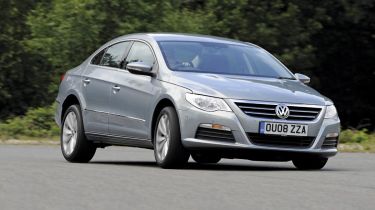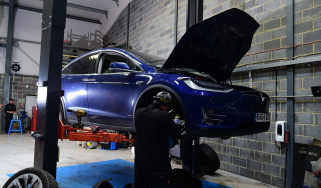VW Passat CC
Is luxury flagship worth the extra cost over standard model?
The Passat has never had an image problem – it just hasn’t had an image. While it has climbed further upmarket than any of its family car rivals, it’s seen as solid rather than sexy.
Bear all that in mind, and it’s clear that designers faced a real challenge in creating a version to be sold on styling alone. The result isn’t wild, but there are lines and contours that draw the eye all around.
The shape hasn’t won universal praise, however. Some of our testers think it’s mismatched. At the front, the VW looks similar to a BMW 6-Series; at the rear, a less flattering comparison with Chrysler’s stumpy Sebring can be made. What’s more, the CC name conjures up images of folding hard-tops, rather than sleek saloons.
So, the new Passat is not as naturally beautiful as its Italian rival. Inside, VW has fallen into more familiar territory with its cabin design. Much of the facia and switchgear are shared with the standard Passat, and while everything is plain, this does ensure fine build and a sound layout.
The £1,445 optional heated leather seats on our test model help to keep occupants comfortable up front, and the new VW is just as relaxed in the back. Substantial side bolstering on the two rear seats and a useful centre stowage bin make up for the lack of a fifth seat. Only headroom is sacrificed – anyone over six feet tall will have to slouch in the VW. The narrow glass area gives it a more glamorous feel, while the 740mm legroom trumps the Alfa by 80mm.
The German model’s load space is more practical, too. A capacity of 532 litres is not only a substantial 127 litres bigger than the 159’s, but also 47 litres ahead of the standard Passat saloon’s! Drop the rear seats, and there’s a two-metre load length, although the floor is shallow. As long as you don’t need to carry five, there are no real sacrifices to practicality. But have any dynamic compromises been made? If you weren’t excited by the CC’s styling, prepare for a similar experience behind the wheel.
VW has stuck with the Passat’s strengths, creating a relaxed long-distance cruiser rather than a sports saloon. The CC has a smooth ride, and the front-wheel-drive chassis is surprisingly capable in corners, resisting understeer and body roll well. But the lack of communication throughthe steering wheel is disappointing.
Don’t think performance from this base 1.8 petrol model is sluggish, though. The turbo is responsive, and the CC covered 0-60mph in 8.3 seconds – four-tenths quicker than the non-turbo 2.2-litre 159.
Priced at £21,040, the entry-level TSI is our pick of the CC range – you can spend up to £31,120, for the V6 variant. It’s an impressive package, but is the VW a cut above Alfa’s head-turning saloon?
Details
Price: £21,040
Model tested: VW Passat CC 1.8 TSI
Chart position: 1
WHY: Entry-level version of VW’s four-door coupé has style at an accessible price.
Economy
With the help of VW’s latest engine technology, the Passat CC manages to mix strong performance with decent economy. Our average of 33.4mpg is close to the car’s claimed combined figure of 37.2mpg. The powerplant’s emissions are reasonable at 180g/km, although they still place the German model in the 24 per cent company car tax bracket. So fuel bills will be cheaper in the Passat CC than the 159, but servicing is more costly, with three years’ maintenance weighing in at £849 – that’s £159 more than the Alfa. In entry-level trim, the VW also manages to undercut the 159 in Lusso spec by £1,715.







